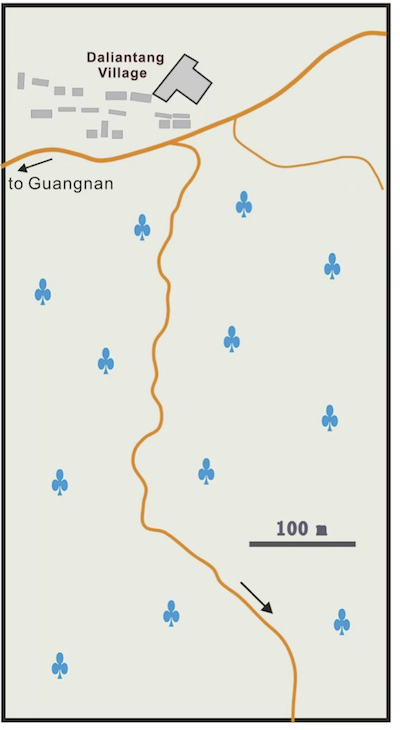Daliantang Fm
Type Locality and Naming
The type section is located at south of Daliantang village (105°5’15’’E—21°7’30’’N), along a mountain path by the artificial small trench, 8 km NNE of Guangnan County, Yunnan Province.
It was named by Liao Weihua et al. in 1978. A set of deposits characterized mainly by the thin-bedded limestones with cherts between Pojiao Fm below and siliceous rocks of Liujiang Fm above in SE Yunnan and SW Guangxi was named by Liao et al. as Daliantang Fm and Pozheluo Fm (Pozhela Fm). Zhang Y.Z et al. of Yunnan Geological Survey pointed out that the two units are defined by biostratigraphy and no essential differences in lithology. Therefore, the name of Pozheluo Fm is abandoned in Yunnan..
[Figure Map showing the locality of stratotype section of Daliantang Formation.]
Lithology and Thickness
Siliceous limestone. The formation is mainly composed mainly of thin-bedded bioclastic limestones with siliceous concretions, bands and layers intercalated with few dolomites, phosphorus-bearing clay rocks in the middle and upper parts, locally alternating with cherts. Its lower part is characterized by thick – to medium limestone. It is 167 m thick.
[Figure Outcrops of Daliangtang Formation in the type locality. An overlooking a cliff comprising of the thin-bedded limestones (above). The basal thick-bedded limestone with a small cave overlying the Pojiao Fm (lower left). Medium-bedded limestones in the middle part of the Formation (lower right).]
Relationships and Distribution
Lower contact
Conformable contact onto the underlying gray, grayish-green mudstone of the Pojiao Fm, although Wenshan locality column shows a thin Bajiaoqing Fm is shown at that contact.
Upper contact
Unclear with the overlying strata; but Wenshan locality column shows an upward lateral shift to dominance by the Gumu Fm, followed by Liujiang Fm.
Regional extent
It is widely distributed in Guangnan, Funing, Malipo in southeast Yunnan and Napo, Jingxi, Debao of southwest Guangxi. Daliantang Formation is laterally equivalent of the Pingen Fm (Ping'en Fm) plus Sanchahe Fm of SW Guangxi
GeoJSON
Fossils
The formation contains abundant fossils, including tentaculites of Nowakia praecursor zone and N. barrandei zone; ammonoids of Anetoceras-Erbenoceras zone and Teicherticeras zone; and conodonts: Polygnathus grombergi, P. serotinus.
Age
Depositional setting
It is interpreted as slope and deep-water basin environment.
Additional Information

